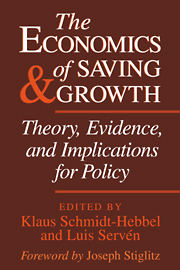4 - Financial Policies and Saving
Published online by Cambridge University Press: 18 December 2009
Summary
Introduction
The financial sector plays an important role in the saving process. On the one hand, use of financial instruments offers the household saver wide, albeit indirect, access to the yield on the investment opportunities available in the economy. An established literature stresses the importance of ensuring effective operation of this channel, as intermediated savings are likely to be more productive than where the household saver is limited to his or her own production and storage technologies. Of course, not all saving involves the accumulation of financial assets; furthermore, the characteristics of different financial assets likely influence the total volume of saving much less than they do the composition of the savings portfolio, a topic that is not dealt with here.
On the other hand, reliable access to borrowed funds through the financial system can reduce precautionary saving as well, turning some households into dissavers. Recently, the rapid deregulation of financial systems in many industrial countries has highlighted the fact that financial repression may have constrained some households from borrowing more than it constrained others from saving. Although financial liberalization can enhance the efficiency with which saved resources are channeled into productive use, the suspicion that it may have contributed to the sharp decline in saving ratios in many industrial countries has brought financial-sector policy to the fore in the discussion of saving.
Differences in the structure and performance of the financial sector in different parts of the world may help explain some of the empirical contrasts noted in Chapter 2 – for example, in regard to the historical average decline in savings rates and the fact that this decline has been absent in many Asian countries.
- Type
- Chapter
- Information
- The Economics of Saving and GrowthTheory, Evidence, and Implications for Policy, pp. 71 - 106Publisher: Cambridge University PressPrint publication year: 1999
- 5
- Cited by



